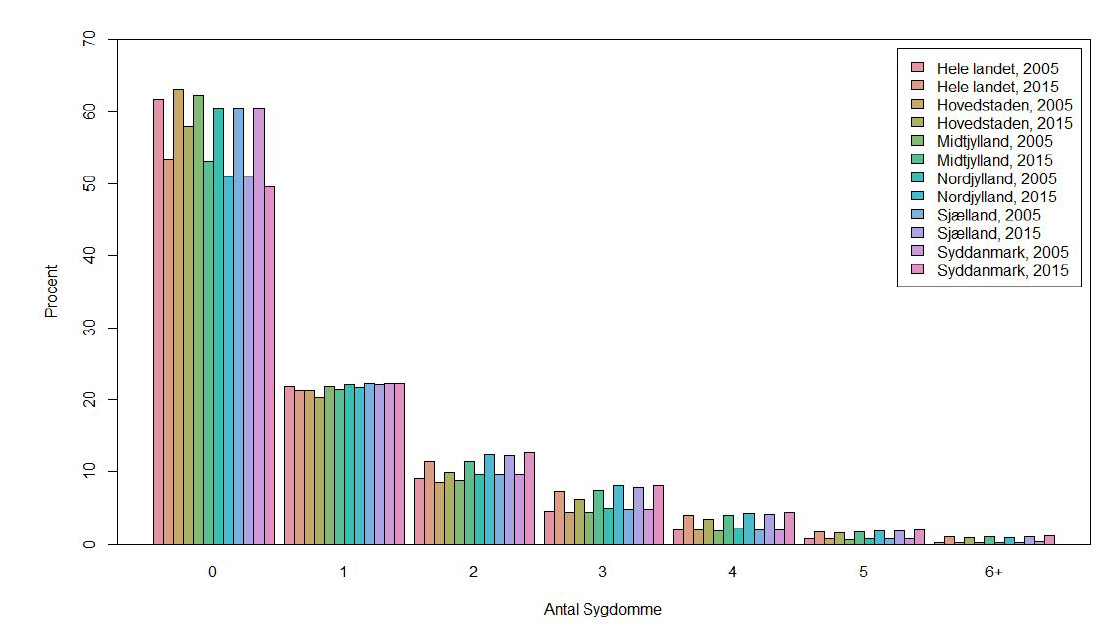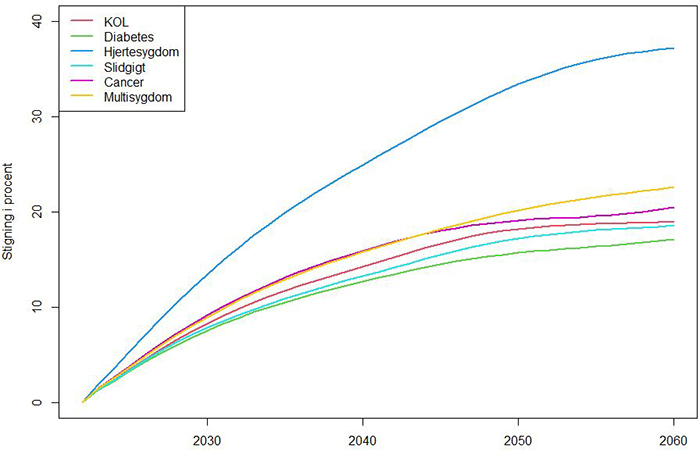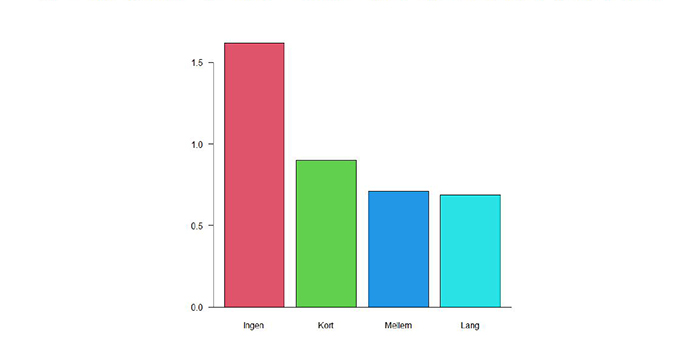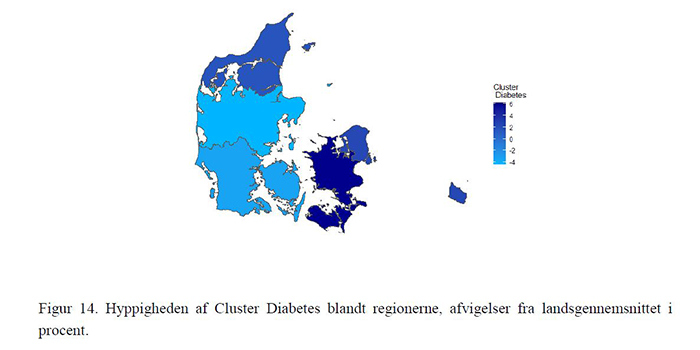Danes are living for longer and longer, and this may challenge the healthcare system in the future. A prediction made by DTU, University of Copenhagen and the Research Center for Multimorbidity and Chronic Diseases at Region Zealand for the Danish population shows that individual patients are getting more diseases in the future. The number of patients with chronic heart disease alone is expected to increase by 33 percent towards 2050 if the health of the population is not improved.
Danes can expect to live longer; figures from Statistics Denmark show that the life expectancy for newborns has increased by almost two months per year for the last 50 years. But the nice gain in life expectancy also means that Danes get more illnesses. It can therefore be a challenge to exchange the extra lifespan for extra good years of life.
Already today, the healthcare system is under pressure due to a lack of healthcare staff and beds. Now a new report shows that it can get much worse if regions and municipalities do not think of new ways to prevent and treat chronic diseases. A prediction based on extensive data shows that towards 2050 there will be many more patients with 2, 3, 4, 5 and 6 chronic diseases. Today, the incidence of multimorbidity, where the same patient has two or more chronic diseases, is between 21-37% in the Danish population, depending on the region they live in. The incidence is expected to increase by approximately 1.4% per year for the next 10 years.
If nothing is done, and ongoing efforts to improve public health such as 'healthy aging' do not take effect, the number of patients with chronic heart disease in 2050 will have increased by 33%. The fact that in the future chronic heart disease in particular seems to have a major impact on the pressure on the healthcare system is probably due to the fact that people do not die from heart disease to the same extent as other serious diseases, but live with heart disease into old age, the researchers conclude. For cancer, the increase is expected to be 19%, COPD 18%, osteoarthritis 17% and diabetes 16%. The increase is also due to population growth.
The report was made for Danish Regions and written by Associate Professor and Data Scientist Anders Stockmarr from DTU Compute and Anne Frølich, Clinical Professor at the University of Copenhagen and Head of the Research Center for Multimorbidity and Chronic Diseases at Slagelse Hospital, Region Zealand..
"It is actually a success story for the healthcare system that we are living longer. The results are important in relation to planning which specialties and the capacity of these that will be needed over the coming years. Our predictions show that while there were approximately 1.2 million multiple chronic conditions in Denmark in 2022, corresponding to 26% of the population, we expect this number to increase by almost 300,000 to 1.5 million in 2050 if no efforts are taken to improve the population’s health, says Anders Stockmarr.
Anne Frølich adds:
"It is actually a success story for the healthcare system that we are living longer. The results are important in relation to planning which specialties and the capacity of these that will be needed over the coming years. Our predictions show that while there were approximately 1.2 million multiple chronic conditions in Denmark in 2022, corresponding to 26% of the population, we expect this number to increase by almost 300,000 to 1.5 million in 2050 if no efforts are taken to improve the population’s health."
Associate Professor and Data Scientist Anders Stockmarr from DTU Compute
“Unfortunately, multimorbidity poses a burden for the individual patient with reduced health-related quality of life, often reduced physical ability, and increased risk of hospital admissions and early death. Multimorbidity also represents a substantial financial burden for both the healthcare system and for society, if we do not start to think differently and organize our health system in a way so that we can prevent the development of multimorbidity."
Statistics for all Danes ages 18+
The researchers have used a new way to calculate the numbers and make predictions, using register information, which not only includes hospitalizations, but also medication and information from a number of other registers for all Danes ages 18+.
The estimate confirms the observed development in the figures from 2005 up to 2015, where the healthcare system is comparable, so an increase will not be explained by an increased focus on diagnosing diseases.
Three Danish regions in particular - Region Zealand, Region of Southern Denmark and North Denmark Region - stand out with a greater incidence of multimorbidity, which relates to these regions' population composition with an older population, and a generally lower level of education.
A unique overview of disease patterns
The report also describes an important connection between typical disease patterns for multimorbidity and social inequality.
Here, the researchers identify five so-called disease clusters where chronic diseases of the patients express specific patterns. The clusters represent archetypes of citizens with certain characteristics described by diagnostic compositions. From this, other characteristics of these archetypes can be derived, such as education level, age, frequency of sex, employment rate, pension and consumption of healthcare services.
The researchers have also had the opportunity to look into the figures for the individual municipalities. They show that even if a region nationally has fewer people with serious chronic diseases than other regions, there can be a big difference in health between the municipalities. Municipalities with a high proportion of citizens with higher education will tend to have fewer people with serious chronic diseases, while municipalities with a low proportion of citizens with higher education will typically have more citizens with serious chronic diseases.
The report thus sheds new light on the connection between chronic diseases, and what significance the occurrence of several simultaneous diseases will have for the citizens, the healthcare system and society in general, if prevention is not initiated.
Support clinical guidelines
Generally, patients with multiple chronic diseases will receive healthcare services at multiple locations in the healthcare system; at their family GP, in hospital outpatient clinics and perhaps also in the municipality. This can lead to fragmented treatment processes, where neither the therapists nor the patient have a comprehensive overview of the diseases and their treatments.
The new knowledge about the five disease clusters in the Danish population with multimorbidity can possibly support the development of clinical guidelines aimed at treating patients suffering from several of the major chronic diseases.
"This could potentially promote a broader overall medical treatment of multi-disease patients and simplify and improve the patients' personal medication. In addition, the new knowledge about the five disease clusters may also underpin the organization of healthcare efforts in hospitals, general practice and municipalities," say the researchers.
Below you can see selected figures from the report: Multimorbidity in Denmark – Description of disease clusters and social inequality Research Center for Multimorbidity and Chronic Diseases, 2023.
Figure 1B. The progression in the number of chronic diseases from 0 to 6+ chronic diseases from 2005 to 2015 for the whole country and the five regions. In 2005, Mariager Municipality is counted within Region North Jutland

Figure 3. Predictions of increases in percentage for 5 selected chronic diseases (chronic obstructive pulmonary disease (COPD) - purple, diabetes - green, chronic heart disease - blue, osteoarthritis - light blue, and cancer - pink) as well as multimorbidity - yellow, from 2022 until 2060.

Figure 4. Number of diseases by the level of education. Listed in none (red), short (green), medium (blue) and long education (light blue).

Cluster Diabetes - diabetes and no chronic heart disease: Cluster Diabetes is overrepresented in Region Zealand, Region Hovedstaden and marginally in Region North Jutland. This provides a clear geographical separation between east and west, as depicted in Figure 14.
